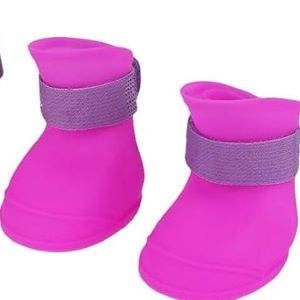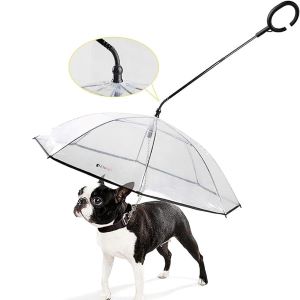Ever wondered how our dogs feels about those unexpected rain showers? We’re about to decode the mysterious canine rain dance and answer the pressing question on every dog’s mind: “How long can dogs be in the rain?”
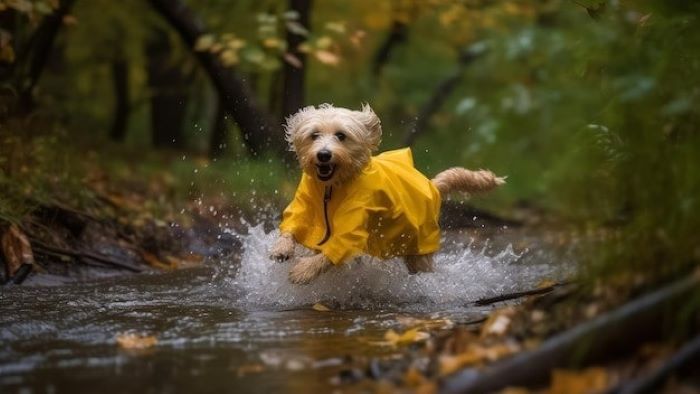
Rainy weather can leave our furry friends with a bit of a dilemma, and like any pet detective, we’re here to uncover the secrets of doggy rain tolerance, and to make sure your furry friend stays cheerful and dry!
Key Takeaways
- A dog’s ability to tolerate rain depends on factors like breed, coat type, and health.
- Prolonged rain exposure can lead to hypothermia. Keep outdoor time in the rain limited to prevent this risk.
- Pay attention to your dog’s signs like shivering, seeking shelter, or changes in body language can indicate discomfort.
- After rainy outings, always dry your dog and provide a warm environment. This helps prevent moisture-related skin issues.
- Rainy days offer opportunities to keep your dog engaged and happy, even when outdoor play is limited.
You Might Also Like:
How Long Can Dogs Be in the Rain?
Here are some guidelines to prioritize your dog’s comfort and safety when deciding how long they can be in the rain:
- Short-Coated Breeds: For short-coated or smaller breeds, like Dachshunds or Chihuahuas, the tolerance for rain is usually lower. Keep their outdoor rain playtime limited to 20-30 minutes. Provide them with a waterproof doggy coat or sweater to help keep them dry and warm.
- Long-Coated Breeds: Dogs with long, water-resistant coats, such as Retrievers or Newfoundlands, can withstand rain for a bit longer. You can allow them to stay outdoors for 45-60 minutes, but it’s essential to check for signs of discomfort like shivering.
- Puppies and Elderly Dogs: Puppies and elderly dogs are more susceptible to the cold and dampness. Keep their time in the rain to a minimum, ideally 15-30 minutes. Ensure they are well-dried and warmed up after their outdoor adventure.

General Recommendations: As a general rule of thumb, it’s advisable to limit your dog’s exposure to rain to no more than 30-60 minutes at a time. Beyond this duration, even dogs with water-resistant coats may start feeling uncomfortable and wet.
Monitoring and Adjusting Based on Individual Needs
Every dog is unique, and some may enjoy rainy weather more than others. Pay attention to your dog’s individual preferences when walking dogs in the rain.
Regardless of breed or age, closely monitor your dog for signs of discomfort such as shivering, seeking shelter, whining, or a tucked tail. If your dog exhibits any of these signs, it’s time to head indoors.
Every dog is unique, and some may enjoy rainy weather more than others. Pay attention to your dog’s individual preferences. If they seem happy and playful in the rain, you can extend their time slightly, but always prioritize their comfort and well-being.
After any rainy outdoor time, be sure to thoroughly dry your dog with a towel and provide a warm, cosy spot indoors to help them regain their body heat.
Factors Affecting a Dog’s Tolerance to Rain
A dog’s tolerance to rain depends on various factors, Being aware of these factors can help you make informed decisions to keep your dog comfortable and safe in wet weather:
Breed-specific considerations
Here are some considerations by specific breeds:
- Water-Resistant Breeds: Some breeds have developed water-resistant characteristics due to their historical roles in activities like retrieving in water. Breeds like Labrador Retrievers, Newfoundlands, and Portuguese Water Dogs tend to handle rain better. Their thick, water-resistant coats and natural swimming abilities offer them an advantage.
- Non-Water-Resistant Breeds: On the other hand, certain breeds are less equipped for rainy conditions. Breeds with short fur or those originating from warmer climates, like Chihuahuas or Greyhounds, may be more sensitive to the cold and discomfort associated with wet conditions.
Coat Type and Length
Let’s see some factors that depend on a coat of dogs:
- Short Coats: Dogs with short, sleek coats have less natural insulation against the cold and wet. These breeds are more susceptible to getting wet quickly and may become uncomfortable sooner. Examples include Dalmatians and Boxers.
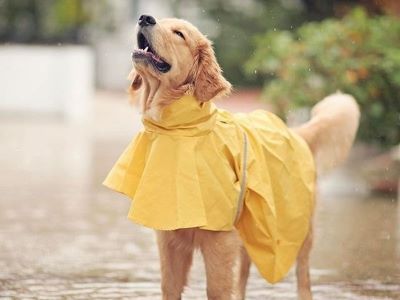
- Long Coats: Dogs with long, dense fur may have better protection against rain. However, their fur can become heavy when soaked, making them uncomfortable over time. Breeds like Siberian Huskies and Bernese Mountain Dogs have long, dense coats.
Age and Health Condition
Here are some factors depending on the health condition of dogs:
- Puppies: Young puppies have less developed thermoregulation, and their smaller bodies lose heat more rapidly. This makes them more vulnerable to the cold and dampness associated with rain. Puppies should be kept dry and warm in rainy weather.
- Elderly Dogs: Older dogs may have weaker immune systems and be more susceptible to illnesses exacerbated by dampness, such as arthritis. It’s essential to provide them with extra protection during rainy conditions.
Temperature and Climate
Some factors derived by the climatic conditions:
- Temperature: Cold rain is more uncomfortable for dogs, particularly those not adapted to cold weather. A chilly, wet dog can experience a drop in body temperature, leading to conditions like hypothermia. Warmer rain may be better tolerated but can still lead to discomfort.
- Climate: Dogs accustomed to rainy climates may have higher tolerance compared to those from drier regions. Dogs from rainy regions often have specific adaptations in their coats and behavior to deal with frequent rain.
Individual Preferences
Dogs, like humans, have unique personalities and preferences. Some dogs may not mind rain and may even enjoy splashing in puddles, while others may detest getting wet. Pay attention to your dog’s behaviour and body language to understand their individual preferences and comfort levels.
Understanding the Risks
Understanding these potential issues and taking appropriate precautions, you can help keep your dog safe, comfortable, and healthy during wet weather:
1. Hypothermia
“Hypothermia occurs when a dog’s body temperature drops below the normal range due to prolonged exposure to cold and wet conditions. Rain can significantly contribute to this condition, especially if the rainwater is cold or if the dog’s coat becomes soaked”, confirms Dr Jennifer Coates at PetMD.
Signs of hypothermia in dogs include shivering, lethargy, pale gums, a drop in body temperature, and even confusion or loss of consciousness[1]
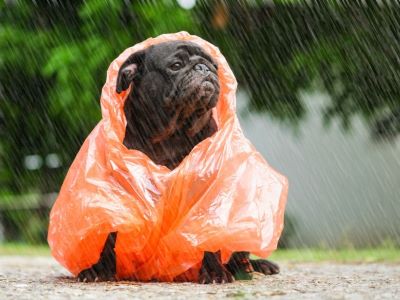
To prevent hypothermia, limit your dog’s time in the rain and ensure they are adequately dried and warmed after exposure. Dressing them in a waterproof coat or sweater can also help retain their body heat.
2. Health Conditions by Rain Exposure
Rain exposure can exacerbate existing health conditions in dogs. “For example, dogs with arthritis may experience increased joint pain due to the cold and dampness. Signs of exacerbated health conditions may include limping, stiffness, or difficulty moving“, confirms Dr Ryan Llera from VCA Hospitals.
If your dog has pre-existing health conditions, consult with your veterinarian about managing their exposure to rainy weather. Providing a dry and warm environment is essential for their comfort and well-being.
3. Behavioral Changes
Rain can affect a dog’s behaviour and mood. Some dogs may become anxious, agitated, or reluctant to go outside in the rain, which can impact their exercise and mental stimulation. Behavioral changes can include whining, restlessness, or avoidance of outdoor areas.
Be patient with your dog’s rain-related behaviour changes. Use positive reinforcement to encourage outdoor activities, offer treats, and provide sheltered areas to make them feel more secure and comfortable.
4. Moisture-Related Skin Issues
Constant exposure to rain can lead to moisture-related skin problems. Prolonged dampness can create a breeding ground for skin infections, hot spots, or fungal issues. Signs of moisture-related skin problems may include redness, itching, flaking, and a foul odour from the skin.
Regularly check your dog’s skin for any signs of irritation or infection, especially after rainy outings. Ensure your dog is thoroughly dried after being in the rain, paying particular attention to dry their paws and between the toes.
5. Safety Concerns
Rain can create slippery surfaces, making it easier for dogs to slip and injure themselves. Rain can also reduce visibility for both you and your dog during walks, increasing the risk of accidents.
Injuries from slips or accidents can vary widely, from minor scrapes to more severe trauma. During rainy walks, be cautious of slippery paths, and consider using non-slip boots for your dog if necessary.
Use reflective gear or accessories to enhance visibility in low-light conditions to ensure both you and your dog’s safety.
Signs of Discomfort or Distress
Understanding the signs of discomfort in your dog is crucial to ensure their well-being during rainy weather. Here are some of them:
- Shivering: It is a clear sign that your dog is feeling cold and uncomfortable in the rain. It’s their body’s natural response to try to generate warmth. If your dog is shivering, it’s time to bring them indoors or provide shelter immediately. Dry them off with a towel and ensure they have a warm, dry environment.
- Whining: Dogs may whine or vocalize when they’re distressed or unhappy. Rain can be a source of stress for some dogs, leading to vocalization. Listen to your dog’s vocal cues. If they are whining or showing signs of distress, consider taking them inside or providing a dry area.
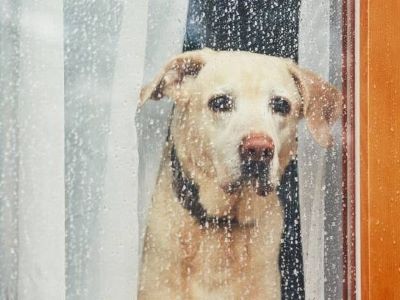
- Seeking Shelter: Dogs naturally seek shelter when they feel uncomfortable or exposed to unfavorable weather conditions. If they try to hide or escape the rain, it’s a sign they’re not enjoying it, they are indicating a desire to go indoors or under a covered area, follow their lead and provide a dry, safe space.
- Changes in Body Language: A dog’s tucked tail is a common sign of anxiety or discomfort, indicating that they are trying to protect themselves. It’s essential to remove them from the rainy situation and offer comfort and warmth.
- Rapid Breathing: Rapid or shallow breathing can indicate that your dog is experiencing stress or discomfort due to the rain, especially if they are also shivering. If rapid breathing persists, consult with your vet as it could indicate an underlying issue.
If your dog is exhibiting signs of distress in the rain like shivering or seeking shelter, it’s time to bring them indoors or provide a dry area. You may also want to consider whether, do dogs need coats in the rain to keep them more comfortable.
Rainy Day Precautions
On rainy days, it’s essential to take precautions to keep your furry friend comfortable and healthy.
Firstly, ensure there are accessible shelter options like covered areas or a cosy indoor space. Invest in raincoats, umbrella hats for dogs and waterproof gear to keep your dog dry during walks or outdoor playtime.
After rain exposure, always dry your dog thoroughly with a towel to prevent moisture-related skin issues and potential discomfort. Don’t forget to maintain their hydration and nutrition, as staying warm can increase their energy needs.
Lastly, rainy days are an excellent opportunity to engage your dog’s mind with indoor activities and games, ensuring their mental stimulation even when the weather keeps you both indoors.
FAQs
Can Dogs Get Sick From Being Wet and Cold?
Exposure to cold and wet weather for long periods of time can lead to inflammation in the respiratory tract. This inflammation makes dogs more prone to bacteria invasion of the airways—aka, pneumonia. This is a higher risk for young dogs, older dogs with other systemic diseases, and any immunocompromised dog.
How Long Can Dogs Be in the Rain?
You’ll want to consider the time of year and temperature outside. In the dead of winter, leaving a dog outside can be dangerous, especially during heavy rain and sub-zero temperatures. That said, a dog left outside for 15 minutes in a light summer rain will be fine.
Do Dogs Need to Be Dried Out After Rain?
Keeping your pet’s coat dry isn’t possible all the time. But rubbing them dry with a towel after outdoor adventures in the rain or muck is always a good idea. Some pampered pooches prefer the blow dryer, but few dogs can resist a brisk rubdown.
Summary
To wrap it up, knowing how much time dogs can stay in the rain is crucial for being a good pet owner. Dogs are different, so what they can handle varies.
Look out for signs of them not liking the rain, and be prepared with things like shelter and rain gear to keep them comfy.
So, how long can dogs be in the rain? It depends on the dog and what makes them comfortable.
Reference:
- Staff, A. (2023). Hypothermia in dogs: How cold is too cold?- American Kennel Club.

